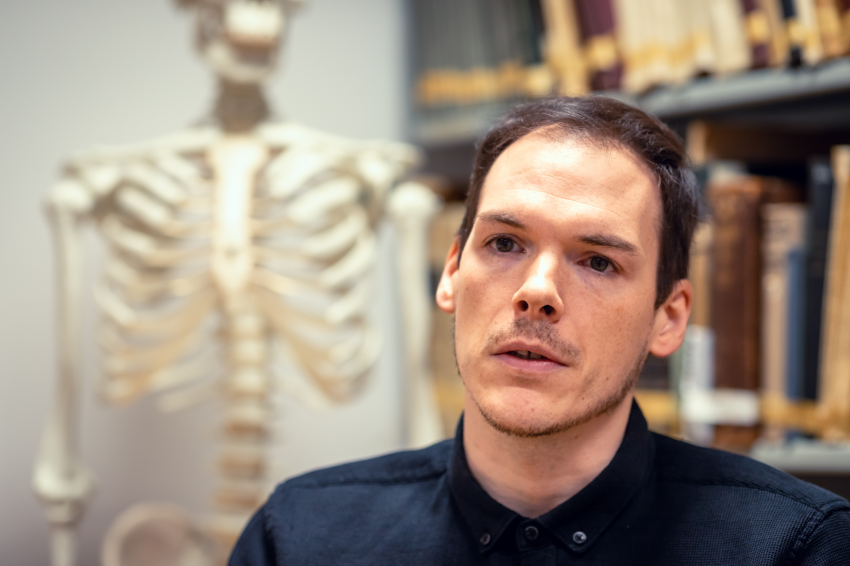
Researchers at the University of Szeged have made an unprecedented discovery related to the era of the Hungarian Conquest in the Carpathian Basin by analyzing human remains in a weapon-filled grave and identifying them as belonging to a woman. How did they determine that the excavated bones were female rather than male? Could this woman have fought in battles? To delve deeper into this remarkable revelation, we spoke with Dr. Balázs Tihanyi, a research fellow at the university’s Department of Biological Anthropology and Department of Genetics, and the lead author of the study that brings these findings to light.
Q: What methods were used to determine that the remains in Grave 63, excavated at the Sárrétudvari–Hízóföld archaeological site in eastern Hungary, were those of a woman rather than a man?
A: As part of our research, we identified the individual’s biological sex by conducting both anthropological and archaeogenetic analyses on the remains.
Q: Prior to any thorough analyses, did the original excavators suspect that the individual might have been a female warrior – based on the items buried in the grave?
A: When the grave was excavated between 1983 and 1985, one of the most striking finds within it was a set of archery equipment. Because weapons and archery equipment are typically associated with men, the individual was initially identified as male. On top of that, the deteriorated condition of the bones limited the scope of anthropological analysis, while the presence of weapons strongly reinforced the belief that the remains belonged to a man. So, it is likely that the anthropological findings were inconclusive, but the archaeological evidence at the time overwhelmingly suggested a male burial. However, the grave also contained a necklace, an item typically associated with female burials. That said, beads have also been found in 10th-century male graves. Meanwhile, the rest of the grave goods were items commonly associated with both sexes. Considering all these factors, researchers concluded that the individual was most likely a man who had been buried with beads.
Q: How did the possibility arise that the person might not have been male?
A: The first doubts emerged around 2017-2018, when my colleague William Berthon and I, both doctoral students at the time, began analyzing the anthropological remains from the Sárrétudvari cemetery. As part of this process, he revisited the data on sex and age, using methods that primarily focus on examining pelvic bones – methods that had not been available for earlier studies. When we re-examined the bones, it became increasingly clear that the individual’s sex might not be as easily determined as previously assumed. However, despite applying these newer anthropological methods, the poor condition of the bones made it impossible to reach a definitive conclusion.
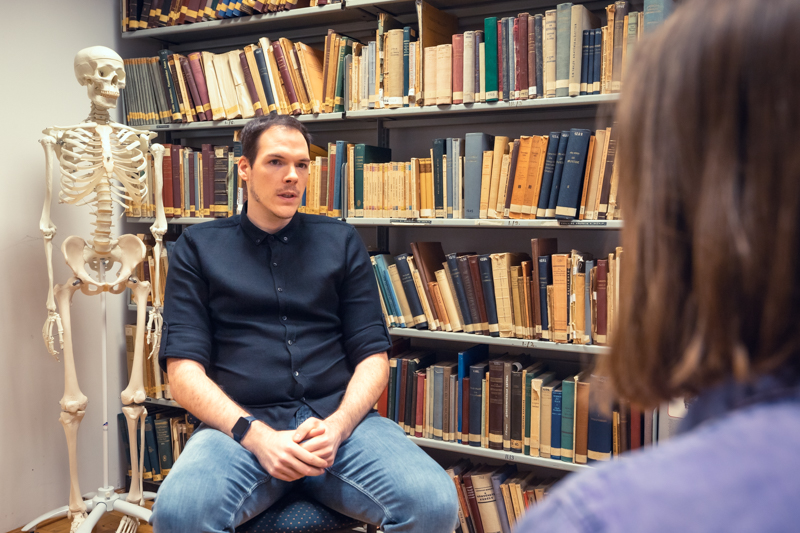
Dr. Balázs Tihanyi
Photo by Ádám Kovács-Jerney
Q: How did you approach the problem?
A: Among the skelatal regions typically analyzed for sex determination using anthropological methods, the skull was the best-preserved. However, it had been crushed under the weight of the soil, requiring us to painstakingly reassemble it from small fragments. Even so, the features that remained intact exhibited distinctly feminine characteristics.
Q: How can a skull be used to determine an individual’s sex? What are the differences between male and female skulls?
A: In males, greater muscle mass results in more pronounced features on the bones, particularly in the muscle attachment areas. The Hungarian method we used is based on analyzing around 12 distinct traits on the skull, focusing on regions such as the brow ridge, the back of the head, the temples, and the jaw. For example, in the brow region, the glabella is more prominent in males, and the mastoid process, located behind the ear, is also much more pronounced and has a rougher surface in males compared to females.
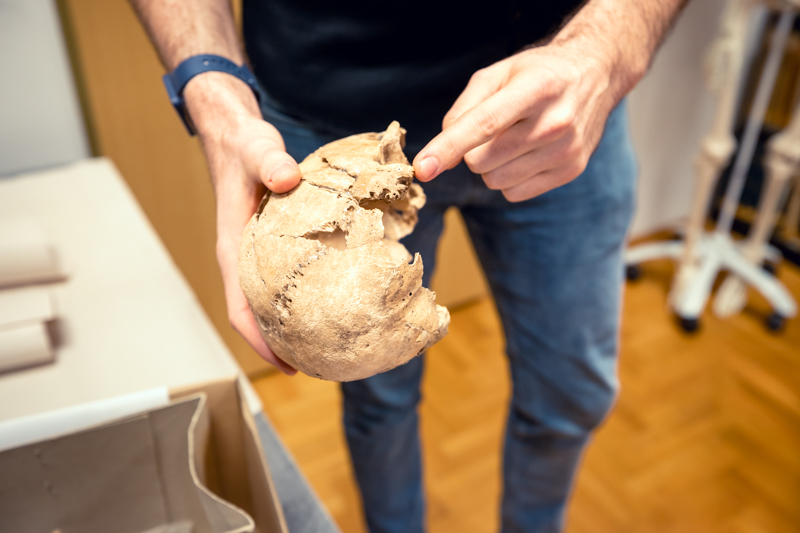
Dr. Balázs Tihanyi demonstrates the differences between female and male skulls.
Photo by Ádám Kovács-Jerney
Q: The prominent Adam’s apple is another feature typically associated with males. But doesn’t that decay? It’s cartilage, if I’m not mistaken.
A: Yes, the Adam’s apple is made of cartilage. While it can be examined in living individuals or forensic cases, under the soil and climate conditions of the Carpathian Basin, only inorganic materials, such as bone, metal, and ceramics, typically survive. Organic materials like cartilage almost always decompose. Nevertheless, even with the skull, there are cases where a female skull can exhibit more masculine traits, or a male skull can display more feminine characteristics.
Q: That makes sense. It’s a spectrum, I suppose. Even among living individuals, there are women with more pronounced facial features and men with softer ones.
A: Exactly. That’s why we examine twelve traits on the skull, weighing and averaging the results. However, if only the skull is available, it’s generally not considered as strong or reliable a marker as the pelvis. In this case, the skull alone wasn’t sufficient – especially because its fragmented state meant that not all parts could be examined. The pelvis shows much clearer differences between males and females. These differences stem from the fact that the female pelvis must adapt to the additional demands of pregnancy and childbirth, while the male pelvis does not have to. As a result, the female pelvis is proportionally wider and shorter, whereas the male pelvis is narrower and taller. Additionally, there are many specific morphological traits in various parts of the pelvis that highlight significant differences between males and females. While the skull also exhibits these differences, they are more subtle – and there is often overlap between the two groups.

The finds from Sárrétudvari-Hízóföld
Photo by Ádám Kovács-Jerney
Q: Following this, genetic analysis was conducted. The published study mentions three different methods, with the Rx method being the most reliable. What makes the Rx method so dependable, and what are the key differences between each of these methods?
A: That’s correct. In genetics, chromosomal sex determination has long been a routine method. It involves identifying sex differences at the chromosomal level. This approach is based on the fact that women have two X chromosomes, while men have one X and one Y chromosome. When an individual’s genome is sequenced, Y chromosome reads appear only in males, whereas the number of X chromosome reads is twice as high in females compared to males. We used two methods, both focusing on these chromosomal characteristics, while the third method was actually a refined or advanced version of one of them. The main difference between the methods lies in how the calculations are performed. The Rx method, in particular, is much better suited for fragmented or incomplete skeletons where the DNA is poorly preserved. Our colleague, Zoltán Maróti, conducted the analysis using both methods; and fortunately, both produced the same result.
Q: Why were samples taken specifically from the areas mentioned in the study, and why was it necessary to analyze three samples?
A: This is partly related to the preservation state of the remains. Genetic research has shown that the best-preserved DNA can be extracted from the so-called petrous bone. Located at the base of the skull, this bone ossifies very early in the developmental process, remains much better preserved in soil, and allows for a significantly higher yield of endogenous DNA due to its dense bone structure. Another area that preserves DNA well is the tooth root. In our case, it would have been sufficient to analyze just one bone. However, this was a particularly unique case, and the main objective of the research was to determine whether the individual was male or female – so we took extra precautions. We wanted to confirm whether the skull and the skeletal bones, which can be packaged separately, would yield the same results, or if there might be a discrepancy, such as the skull showing female characteristics while the skeleton displayed male traits. This was done to rule out any potential mix-ups. Fortunately, all the results pointed to a single individual and confirmed that the remains belonged to a woman.
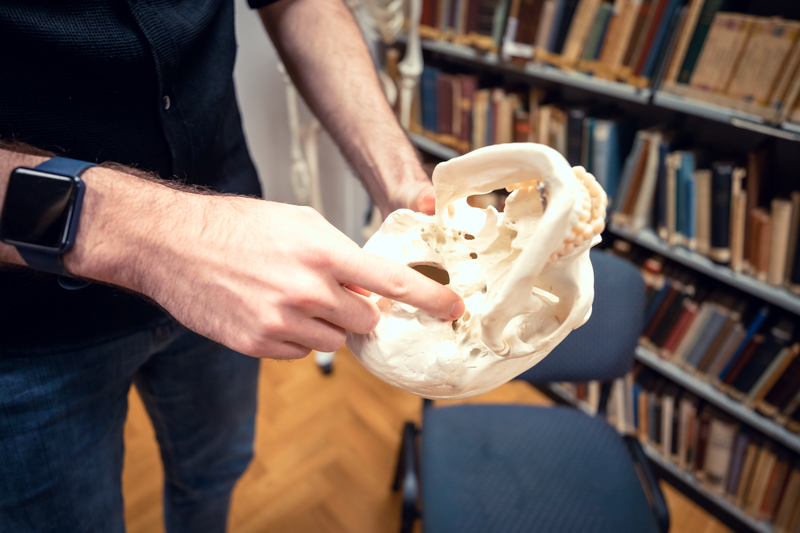
The best-preserved DNA can be extracted from the so-called petrous bone.
Photo by Ádám Kovács-Jerney
Q: The next step was to determine whether the individual had really been a warrior. While the placement of the weapons suggested this, certain factors raised doubts. What in particular called this assumption into question?
A: When weapons are found in a grave, they’re often interpreted as evidence that the individual was a warrior or soldier. However, I approach this classification with caution, because labeling someone as a warrior involves a very specific and complex concept. A warrior, armed with weapons – that is not only a legal and social category but also one that’s difficult to assess using archaeological methods alone. Previous research, primarily based on anthropological and archaeological methods, also calls for caution, highlighting that the presence or absence of weapons in a burial site does not necessarily provide a clear indication of the individual’s occupation or social status, at least not in the way we might define them today.
For example, there have been burials – not only in Hungary but abroad as well – where weapons were placed in graves despite the fact that the deceased could not have used them, either because they were too young or too ill. The inclusion of weapons could symbolize social status or be part of a burial custom. However, this doesn’t automatically mean the individual fought or lived as a warrior.
Written sources and archaeological findings indicate that the bow was the primary weapon of Hungarian conquerors in the 10th century. Yet, bows could also have been used for hunting, not just warfare. Therefore, some caution is necessary when assessing an individual’s role or occupation. That said, for men, weapons are more likely to signify warrior status, as written records confirm that mounted archers were the main fighters in the Hungarian army at the time. Numerous 10th-century male graves containing horse gear and archery equipment support this idea. Until now, however, no comparable evidence has been found for women, and there are no references to female warriors in written sources. This case is so unique that further comparative data is needed to draw more definitive conclusions.
Q: The injuries found on the woman’s bones were also examined. What conclusions were drawn about her lifestyle?
A: Previous studies focusing on injuries in the Hízóföld cemetery show that fractures were far more common among men than among women, especially men buried with weapons or horse gear. For women, bone fractures were extremely rare. In fact, we found few examples of this – with this case being an exception. For this particular individual, fractures were identified on both shoulder blades and upper arm bones. Additionally, the distribution patterns of muscle attachment and joint changes observed on her skeleton resembled those typically seen in men.
Q: Does this mean that these changes likely resulted from a warrior lifestyle?
A: The challenge in evaluating the observed muscle attachment and joint changes is that they can develop not only from physical labor but also from other factors. Characteristics such as sex and age can influence these changes, as well as various metabolic issues, which also affect the alterations that can be seen on bones. In the case of this individual, we observed signs of a metabolic disorder related to osteoporosis – a condition that primarily affects elderly women. While the fractures we identified are certainly linked to physical impact, they were likely caused by falls rather than combat-related activities.
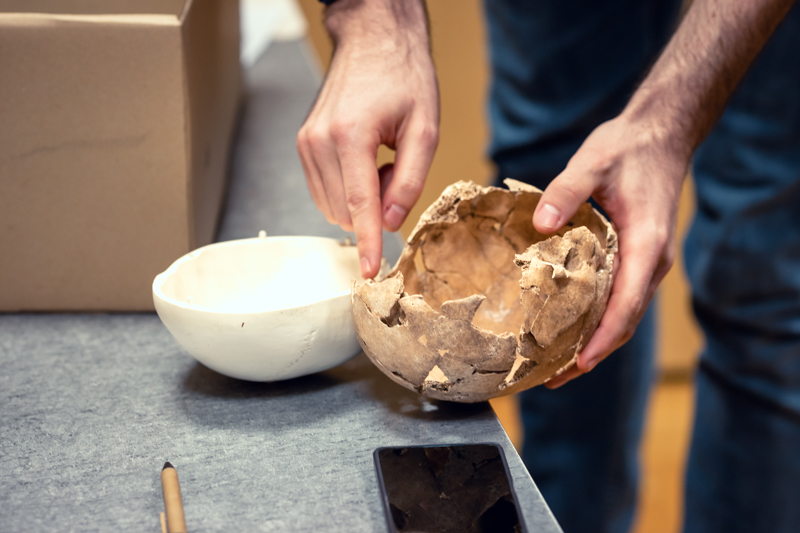
Due to osteoporosis, the skull bone of the find is much thinner than that of Samu, the plastic skeleton in the office.
Photo by Ádám Kovács-Jerney
Q: The light, fragile bones suggest that it was an elderly woman that was buried in Grave 63. Could it be that her numerous injuries were a result of her old age rather than her lifestyle?
A: The fact that such severe injuries developed was certainly influenced by the individual’s advanced age and the presence of osteoporosis, which made the bones more fragile. However, the fractures themselves had to result from significant force, which was probably related to her lifestyle as well. This is especially clear when we consider that multiple fractures, particularly those of the upper limbs, were far more common among individuals buried with horse gear and weapons. It is likely that these individuals led lifestyles that increased their risk of injury – which, in this instance, aligns with our findings.
Q: Indeed, the study published on this case states that the woman clearly led a physically demanding lifestyle, though her exact occupation cannot be determined. The study also mentions an alteration near the femoral neck indicating continuous hip movement. Could this alteration be linked to horseback riding?
A: That’s a great question, as this specific feature highlights the challenges we face in interpreting the results. In the literature, alterations near the femoral neck have often been linked to horseback riding and its effects. However, it cannot be considered a definitive indicator. Several other activities that require similar movements and exertion could have caused this alteration as well. It is also true that while some alterations have been described as more common among riders (often referred to as “rider’s syndrome”), in the case of this individual, the poor preservation of the remains meant that most of these features couldn’t be properly examined. What is clear, though, is that the woman’s lifestyle led to significant wear and tear on her body over the course of her life.
Q: The presence of weapons is not the only unusual aspect of this woman’s burial; the position in which she was laid in the grave is also noteworthy. Apart from her, only one other woman in the Hízóföld cemetery was buried with bent knees. Was the placement of the bow within arm’s reach another unusual feature?
A: The placement of the bow directly beside the body and within arm’s reach is a recurring phenomenon in the Hízóföld cemetery. Although the position of the hands does not provide conclusive evidence of whether she was holding it, the bow was clearly placed close to her hands. Several similar instances have been found throughout the cemetery. Indeed, the bow’s placement, not distant or tucked away in a corner of the grave, suggests that it was buried as a functional tool rather than as an amulet or a purely symbolic object.
Q: Is it possible that the bow found in the grave is an indication of the woman’s warrior lifestyle?
A: The bow’s placement in a functional position, similar to that seen in male graves, does suggest a possible connection to her lifestyle. However, the question of whether she was a warrior cannot be definitively answered at this point.
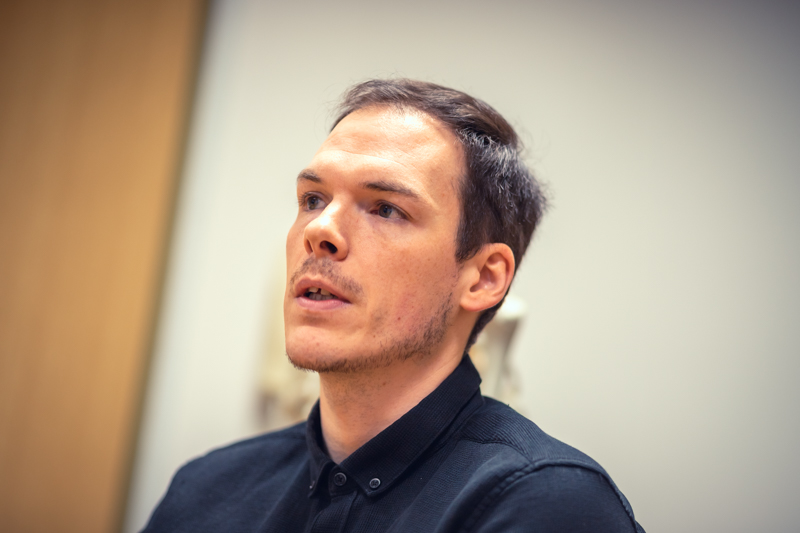
Dr. Balázs Tihanyi
Photo by Ádám Kovács-Jerney
Q: In your opinion, what other disciplines could be incorporated into interdisciplinary research to help determine whether the woman might be considered a warrior? Could fields such as law, ethnography, or philosophy contribute to this analysis?
A: It would certainly be helpful to have written records that indicate whether women could have been involved in such roles. From there, historical studies would be essential for interpreting the data. However, for now, progress in this case will probably come from complex anthropological, genetic, and archaeological examinations. For example, we have documented features on her skeleton, including those related to regular physical labor as well as signs of illness. What remains unclear is whether these features are typical or unique among the women of her community, or even among women living in the 10th century. Moving forward, our goal is to gather comparative data to assess the physical condition of women in the Sárrétudvari community and determine if we can infer anything about their lifestyle.
Original Hungarian text by Helga Balog
Photos by Ádám Kovács-Jerney
The identification of the remains was carried out by current and former staff members of the University of Szeged, particularly from the Department of Biological Anthropology, with the process involving the determination of the sex, age, and other key characteristics of the individual. The department’s anthropological finds from the Hízóföld cemetery are housed in the department’s own collection, which is one of the country’s most significant anthropological collections, comprising approximately 30,000 skeletons – each representing an intriguing case and a life story still waiting to be uncovered.
The anthropological research work took place at the University of Szeged’s Department of Biological Anthropology in collaboration with Dr. Olga Spekker, as well as Dr. Luca Kis, who also created the images and the illustrative drawing of the burial site featured in the study.
The archaeogenetic analyses were performed in the joint laboratory of the Department of Genetics, University of Szeged, and the Research Center for Archaeogenetics, Institute for Hungarian Research (MKI), which focuses on research related to Hungary and Hungarians. The research was carried out under the professional supervision of Dr. Tibor Török (Department of Genetics, University of Szeged) and was also supported by the Centre of Excellence for Interdisciplinary Research, Development, and Innovation (IKIKK) at the University of Szeged.
The laboratory work was completed under the guidance of Dr. Kitti Maár (currently a staff member at the Hungarian Natural History Museum), while the evaluation of the data and genetic sex determination were done by Dr. Zoltán Maróti (Department of Pediatrics and Pediatric Health Care Center at the Albert Szent-Györgyi Medical School of the University of Szeged).

